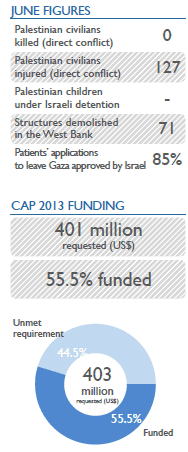
|
|
Despite increased hopes this month regarding political negotiations, the situation on the ground remains fragile and characterized by high levels of vulnerability amongst the civilian population. Key trends identified during the first half of 2013 include an increase in the number of Palestinians injured by Israeli forces, as well as an increased number of Palestinians forcibly displaced from their homes due to demolitions. While June was relatively calm, during the first six months of 2013 as a whole, a total of 2,640 Palestinian civilians were injured by Israeli forces across the West Bank – an average of 440 per month (January to June). This is the highest monthly average since OCHA began recording civilian casualties in 2005. About 75 percent of this year’s injuries were sustained in the course of clashes during protests. Over 40 per cent of all injuries related to rubber-coated metal bullets and 3 per cent were caused by live ammunition. Concerns about the excessive use of force by Israeli security forces in law enforcement, including in the policing of demonstrations, have been repeatedly expressed by the UN Secretary-General. The first half of 2013 also witnessed a rising trend in demolition by the Israeli authorities of structures in East Jerusalem and Area C of the West Bank due to lack of an Israeli-issued building permit. Despite the relative lull in February and March, approximately 350 structures were demolished so far this year (January to June), displacing nearly 600 people; this represents a 14 and 33 per cent increase respectively, compared to the previous year (monthly averages). While most incidents occurred in Area C, the rate of increase was particularly marked in East Jerusalem, where the number of people displaced has increased over four-fold compared to 2012. At least 54 of the structures demolished this year in Area C were funded by humanitarian donors and had, in most cases, been provided by humanitarian agencies in response to previous demolitions of Palestinian owned structures. Israel must halt such demolitions until a fair and non-discriminatory planning system is put in place that guarantees the rights and facilitates the needs of Palestinian communities in Area C and East Jerusalem. Provision of assistance to displaced families in the Gaza Strip also faced serious challenges this month – the implementation by the Egyptian authorities of measures aimed at shutting down illicit tunnels under the Egypt-Gaza border has resulted in a drastic reduction in the volume of building materials entering Gaza. The shortage of materials has brought the |
implementation of housing self-help programs for families whose homes were damaged or destroyed during past hostilities to a standstill; an estimated 1,800 families are still displaced following past hostilities (including in November 2012) and are living in temporary rented accommodation or with host families. Tunnels have proliferated as a result of Israel’s imposition of severe restrictions on import of building materials through official crossings. This latest situation highlights once again the urgent need for Israel to lift its long-term restrictions on official entry and exit of goods to and from the Gaza Strip. |
Download Document Files: https://unispal.un.org/pdfs/HB0613.pdf
Document Type: Map, Report, Status report
Document Sources: Office for the Coordination of Humanitarian Affairs (OCHA)
Subject: Access and movement, Armed conflict, Casualties, Ceasefire, Children, Closures/Curfews/Blockades, Economic issues, Education and culture, Fence, Gaza Strip, Health, House demolitions, Human rights and international humanitarian law, Humanitarian relief, Internally displaced persons, Land, Living conditions, NGOs/Civil Society, Protection, Separation barrier, Settlements, Wall
Publication Date: 30/06/2013







